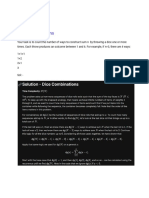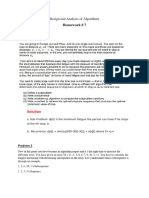0% found this document useful (0 votes)
21 views2 pagesDP Pattern
The document contains two classes implementing dynamic programming solutions for specific problems. The first class finds the length of the longest subsequence that sums to a target using a memoization approach, while the second class computes the minimum path sum in a grid. It also suggests using 1e9 instead of INT_MAX to avoid integer overflow issues.
Uploaded by
Yash MathuriaCopyright
© © All Rights Reserved
We take content rights seriously. If you suspect this is your content, claim it here.
Available Formats
Download as DOCX, PDF, TXT or read online on Scribd
0% found this document useful (0 votes)
21 views2 pagesDP Pattern
The document contains two classes implementing dynamic programming solutions for specific problems. The first class finds the length of the longest subsequence that sums to a target using a memoization approach, while the second class computes the minimum path sum in a grid. It also suggests using 1e9 instead of INT_MAX to avoid integer overflow issues.
Uploaded by
Yash MathuriaCopyright
© © All Rights Reserved
We take content rights seriously. If you suspect this is your content, claim it here.
Available Formats
Download as DOCX, PDF, TXT or read online on Scribd
/ 2


































































